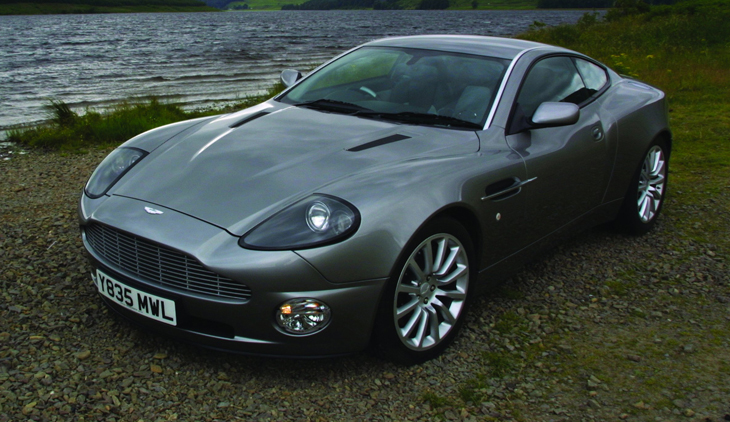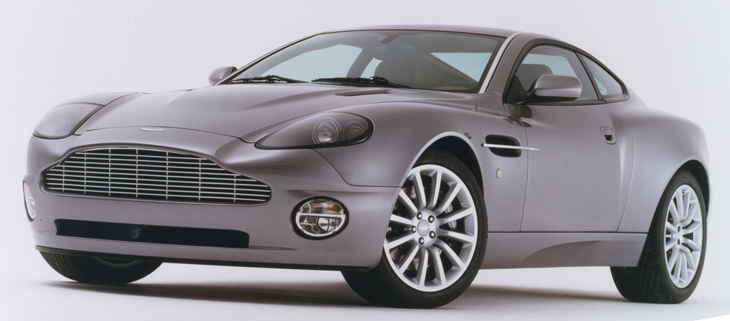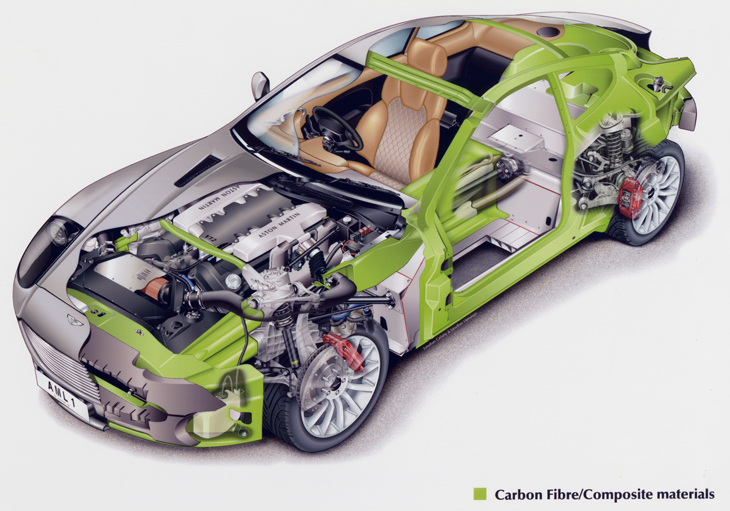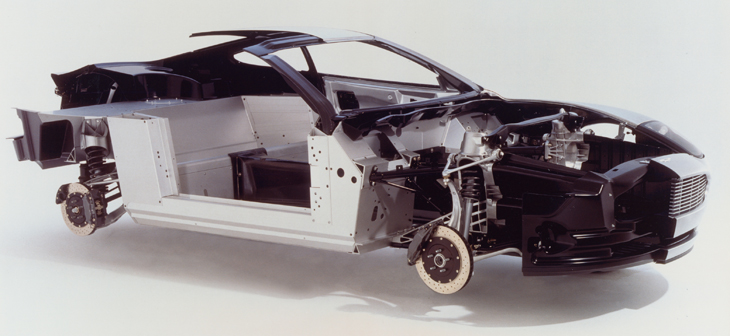
Vanquish
- Production Dates: August 2001 – 2005
The Aston Martin V12 Vanquish is one of the most sophisticated and technologically advanced cars in the world today.
Built at Newport Pagnell, the Vanquish continues to be Aston Martin’s flagship model.
In conjunction with the electronic drive-by-wire throttle system which is fitted to the second generation 460 horsepower 6.0 litre V12 Aston Martin engine, finger tip controlled Formula 1 style paddles enable almost imperceptible gear changes to be completed in under 250 milliseconds – less than the blink of an eye.
Advanced electronics also permit the close ratio six speed manual transmission to be programmed to operate automatically with the added facility of a special programme tailored to winter driving conditions.
The main body structure utilises carbon fibre, extruded aluminium and composite materials bonded together to form a central monocoque safety cell with additional deformable composite structure energy absorbent zones at both front and rear. It provides high standards of efficiency, structural integrity, torsional rigidity and occupant crash protection.
International award winning designer Ian Callum’s elegant, classic body design which reflects the pedigree, heritage and tradition of Aston Martin is both bold and dynamic with finely detailed features for the interior and the exterior.
With the capacity to continue to turn heads the design of the V12 Vanquish is already established as a modern classic. Perfectly proportioned from every aspect, Ian Callum’s design confirms the promise of outstanding “Supercar” performance and the impeccable pedigree of the V12 Vanquish as the new flagship of Aston Martin. Every carefully detailed feature provides graphic evidence of the painstaking craftsmanship and quality which is invested in its construction.
All the exterior body panels are constructed from aluminium with each individual panel hand tailored to the central structure to ensure a perfect panel fit.
The V12 Vanquish is available as either a two or two plus two seat coupe with each and every model hand-built, finished and equipped to the exact and individual requirements of its customer. The V12 Vanquish benefits from a comprehensive and exhaustive test programme with 50 prototypes covering more than 1.6 million kilometres (1.0 million miles). Components and systems were subjected to a series of exhaustive trials on test rigs in Ford Research and Development Centres in Britain, mainland Europe and the United States. In order to assess the integrity and durability of the bonded body structure an environmental wind tunnel was employed to subject a Vanquish body to extremes of temperature ranging from minus 40°C to plus 81°C.
At the concept stage the new V12 Vanquish was previewed at a series of international motor shows in North America and Europe during the first half of 1998.
Such was the response to Project Vantage that immediately following its public unveiling at the North American International Auto Show in January 1998 the decision was taken to proceed with production.
The Body Structure
The main body structure of the V12 Vanquish including the floor and the front and rear bulkheads is formed from extruded aluminium sections bonded and riveted around the central transmission tunnel which is constructed entirely from carbon fibre.
Single piece composite inner body side sections with carbon fibre windscreen pillars are also bonded to the central structure to create a high strength safety cell.
The precise, computer controlled, manufacturing processes which have been developed in Cupertino with Ford Research Laboratories and Nottingham University for the construction of the composite sections and the carbon fibre windscreen pillars are unique to the production of this latest Aston Martin.
Immediately ahead of the driver and passenger compartment a steel, aluminium and carbon fibre subframe carries the engine, transmission and front suspension and is bolted directly to the front bulkhead. There is a further deformable composite structure which employs the distinctive Aston Martin mesh air intake grille as a stressed member located ahead of the engine and front suspension to provide additional crash protection and accommodate the engine, transmission and air conditioning radiators and intercoolers. A completely flat surface has been developed for the underbody enabling air to be channelled into a Venturi section at the rear to assist high speed aerodynamics.
At the rear the composite floor, parcel shelf and side rails of the luggage compartment are also designed to provide additional deformable crash protection together with the extruded aluminium side impact beams located in the doors.
All of the exterior panels, including the roof, bonnet, boot lid, front and rear wings and doors are produced from “super-plastic-formed” and pressed aluminium. However each individual panel is tailored and bonded to the central structure by hand to ensure a perfect fit and finish.
Specification
- Engine:
All alloy twin overhead cam 48 valve 5935cc 60° V12. Compression ratio 10.5:1. Visteon twin PTEC engine management controlling fuel injection, ignition and diagnostics. Fully catalysed stainless steel exhaust system. - Transmission:
Six speed manual gearbox with Auto Shift Manual/Select Shift Manual (ASM/SSM) electro-hydraulic control system. SCP/CAN interface to engine management control system. Limited slip differential 3.69:1 - Steering:
Rack and pinion, variable power assistance 2.73 turns lock to lock. Column tilt and reach adjustment. - Brakes:
Front – Ventilated cross drilled steel discs 355mm diameter with four piston service caliper.
Rear – Ventilated steel discs 330mm diameter with four piston service caliper.
Conti Teves vacuum assisted anti-lock braking system. Electronic brake and engine intervention traction control system. - Suspension:
Front – Independent double aluminium wishbone. Coil springs, monotube damper and anti-roll bar.
Rear – Independent double aluminium wishbone. Coil springs, monotube damper and anti-roll bar. - Body:
Two door style with 2+0 or 2+2 seating. Extruded aluminium and carbon fibre bonded monocoque. Composite front and rear crash structures. Aluminium skin panels. Extruded aluminium door side impact protection beam. Blade mounted washer jets.
Boot space of 0.24 cu m - Wheels and Tyres:
Lightweight forged aluminium alloy wheels 9J x 19 (front), 10J x 19 (rear),
Yokohama 255/40 ZR19 tyres (front), 285/40 ZR19 (rear) - Length: 4665mm.
- Width: 1923mm.
- Height: 1318 mm.
- Kerb Weight: 1835 kgs
- Wheelbase: 2690 mm.
- Fuel tank capacity: 80 litres, 95 RON unleaded fuel only.
- Maximum power: 343kW (460 bhp) @ 6500 rpm.
- Maximum torque: 542 Nm (400 lb. ft) @ 5000 rpm.
- Acceleration: 0-100 km/h (62mph) 5.0 seconds
- Maximum speed: 306 km/h (190mph)






VANQUISH
V12 Vanquish is a car beloved by modern day enthusiasts and also heritage collectors alike. The car’s appearance in ‘Die Another Day’ ensured its place in James Bond history and has helped to make this an instantly recognisable model. Importantly, Vanquish saw huge developments in engineering and design, many of which formed the basis for the development of the current Aston Martin model line-up.
Developed from the 1998 Project Vantage concept car, V12 Vanquish entered production in 2001. Vanquish marked a large step in the company’s engineering featuring a bonded aluminium chassis combined with many pieces of traditional craftsmanship ushering in a new era for Aston Martin
V12 Vanquish featured a body tub made from extruded aluminium and Carbon Fibre with extensive use of more Carbon Fibre and composite materials throughout the crash structure of the car. This extremely rigid and safe body-shell was then clothed in hand-finished, superformed aluminium panels. Underneath the handmade bonnet sat a 460bhp version of the Aston Martin V12 engine, delivering its power via a 6-speed manual gearbox controlled by an electro-hydraulic paddle shift gear change.
In 2002 V12 Vanquish became the latest Aston Martin to be driven by James Bond. This special car was painted in Tungsten Silver and was fitted with a number of non-standard options including rockets, guns, ejector seat, and an invisible ‘cloaking device’ – all provided courtesy of ‘Q-branch’ of course.
Hand-built at the famous Newport Pagnell factory, just 1489 examples of the 460bhp Vanquish were constructed before being replaced by the more powerful V12 Vanquish S in 2005.
